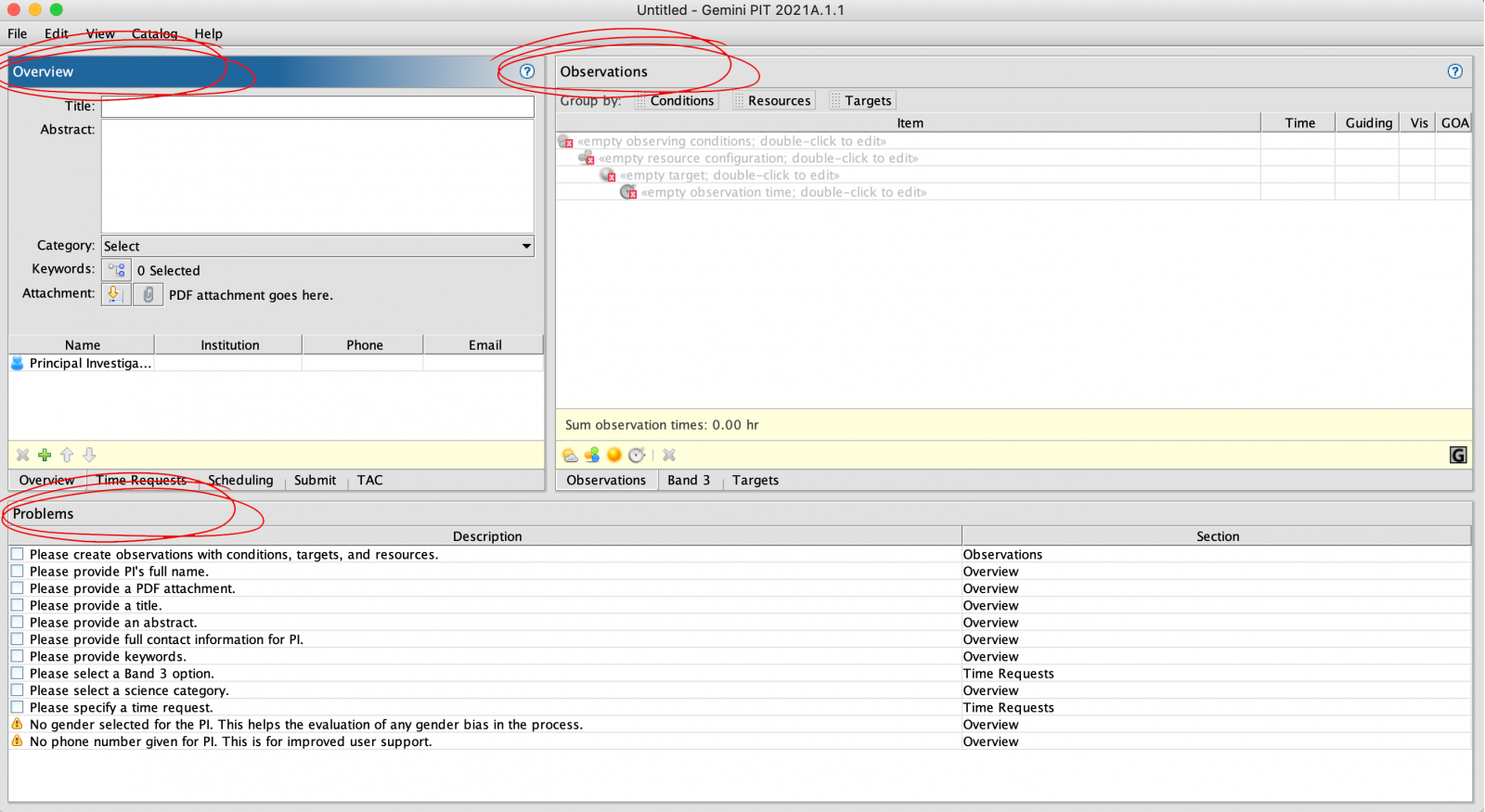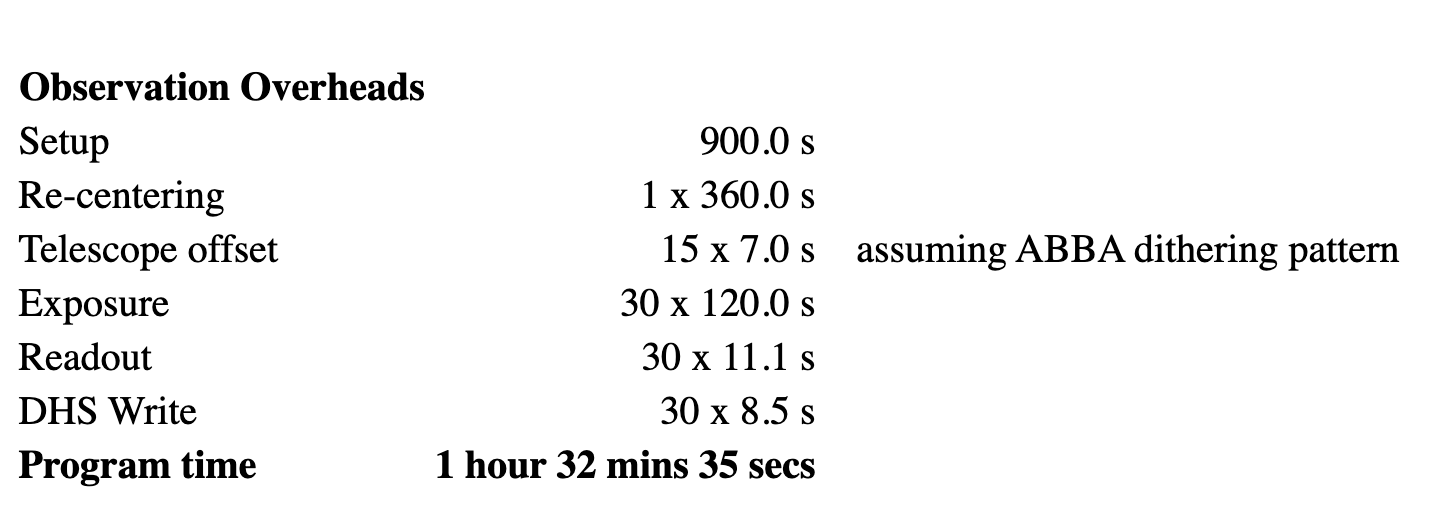Announcements
Understanding PIT
PIT, which is the acronym for Phase I Tool, is the software application that any PI has to use in order to submit a proposal for observing with GNIRS at Gemini North Telescope. In this section we aim to give a brief guideline of how to use efficiently this tool when preparing your proposal. There is a dedicated webpage of Phase I where you can find more detailed information about this first Phase of the proposal preparation.
The latest version of this software can be found here, along with the instructions of how to install it.
Once you open the application you will see the following window, which is divided into three different sections: The "Overview", the "Observation" and the "Problems" section. You can go here to find a detailed description of the PIT software.
 |
Alternatively, there is a suite of tutorial videos that explain very efficiently all the sections and tags of the PIT, and how to submit your proposal. We strongly recommend to watch them before starting to use this software.
How to estimate your program time
At this early stage of the proposal preparation, that is Phase I, you only need to know an estimation of the program time that you will request for your science goals. That time must be set in the PIT software ("Overview" section, "Time request" tag), as explained in the previous section.
The program time is not only the exposure time for your target, you also have to add other time consuming steps, such as the readout, the setup time, among others.
Time for science observations
The proper way to calculate the program time is using the Integration Time Calculator (ITC), where you specify the parameters of your target and the configuration of the instrument you want to use. As a result, the ITC gives the inventary of the observation overheads and the program time. This is an example for a requested total integration time of 1 h (30 x 120 s), and ITC estimates that you will need ~1.5 h of program time.
 |
Baseline calibrations
Note that once you are awarded with observing time and go into Phase II, then you will have to specify the exposure time and the acquisition time, not only for the science target but also for the associated standard telluric. Acquisition images are taken before the observations in order to make sure that the target (science and standard) falls in the correct position wiithin the slit. You will find detailed information in this section.
The baseline calibration consists of a bunch of calibrations (spectral flats, arcs...) that accompany the a science program, and are needed for the reduction of the science data. In other words, these are the by default calibrations by default, however if the PI of the proposal requeres some extra calibrations to carry out the science, these must be defined in Phase II, and the corresponding time is charged as additional time to the program. In the following section, you will find more information about the baseline calibrations. The good news is that in Phase I, you don't have to worry to calculate the the baseline calibration time associated with your proposal, this is automatically estimated in the PIT software.
Checklist for GNIRS Phase I proposals
In order to minimize the most common errors when creating a new program to observe with GNIRS, the PI is strongly encouraged to consider the following Phase I checklist before submitting the proposal.
- Target visibility:
☐ Is your science object visible during the dates of the semester taken into account the observing time requested and the limits on elevation of the telescope?
- Instrument configuration:
☐ Is the filter (for imaging), and the filter + slit + grating (LongSlit Spectroscopy) + prism (for XD spectroscopy) specified in the proposal instrument resource list?
☐ Is the grating you need available?
☐ Does your choice of slit and grating and prism (if requested) give appropriate spectral resolution and spectral coverage?
- Baseline calibrations:
☐ Are the baseline calibrations sufficient? If not, what additional calibration data are required for your program?
☐ (Imaging) If flux calibration is required then the requested conditions should include CC=50%.
☐ Has sufficient observing time been requested for additional non-baseline calibrations?
- Program time:
☐ Make sure that any exposure time is between 0.2 sec and 600 sec.
☐ Is the exposure time and S:N ratio confirmed using the GNIRS ITC? (this table can be used to check recommended acquisition times for several configurations of the instrument).
☐ If additional calibrations are requested, Have the corresponding overheads been included?
☐ Is time included for off-source sky measurements, if needed?
☐ Is the program time given by the ITC the same you have put in the PIT (Phase I Tool)?
- Observing conditions requested:
☐ Is the expected image quality (scaled to the airmass of your target) sufficient for your program? What is the minimum image quality necessary for the science?
☐ What level of cloud cover is acceptable? Is photometric weather required?
Note the product of the probabilities of each of the conditions listed above. This is related to the likelihood of your observations being executed, especially in the lower ranking bands. You might wish to reconsider some of your constraints if the product is very low.